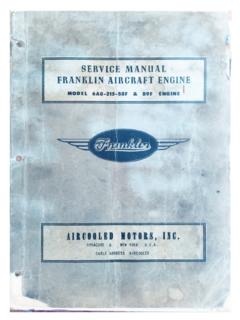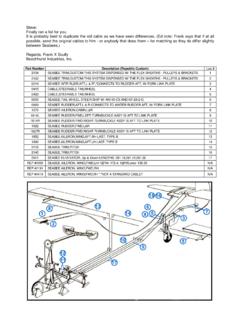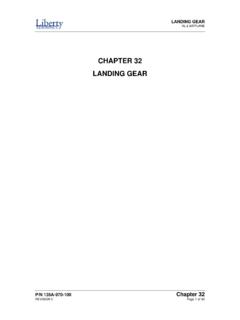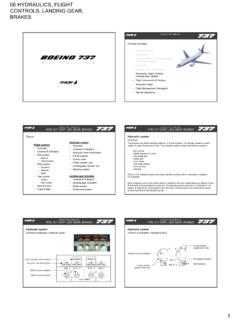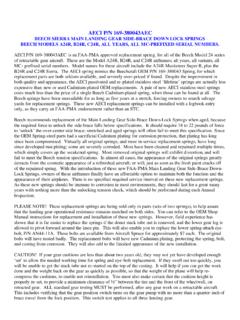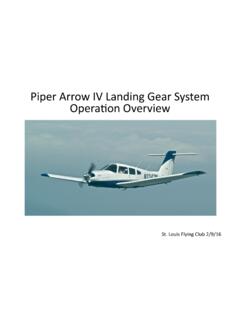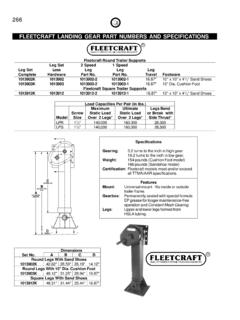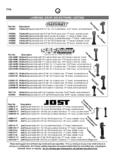Transcription of Sooooo…your Landing Gear Struts Leak. Let’s fix ‘em. NOTE
1 International Republic Seabee Owners Club sooooo your Landing gear Struts Leak. Let's fix em. (by Steve Mestler and Tim Sutter January 4, 2011). NOTE: Before we get started, regardless of position or orientation of the parts being discussed, the TOP of the part is the top as it would be in the normal gear down position. For example, the top of the knuckle is the top as it would look sitting on its Landing gear in the hangar. Obviously the BOTTOM is the lower side of the part, as it would look sitting on the gear . You must have the assistance of a FAA certified mechanic to do this! A logbook entry is required. Also, it cannot be stressed enough to keep your work area and the strut parts clean. Before assembling the Struts , clean the inside areas with denatured alcohol or lacquer thinner.
2 Lubricate all o-rings and internal parts liberally with hydraulic fluid as they are assembled. In some cases waterproof grease is used. If you have noticed a little red hydraulic fluid (5606) under your Landing gear Struts or around the collar, some or all, of your strut seals (O-Rings) may need replacing. This little article explains the procedure for changing ALL (6 or 7) seals in the strut. You must, however, get the assistance of a qualified FAA certified aircraft mechanic to legally change them and sign off the logbook. Chances are the leaky seal is on the bottom of the strut. This seal is sometimes difficult to change as some axles have been welded to the strut itself. This was done as an after-Republic modification and if you are lucky, the axles have not been welded to the strut.
3 Don't get me wrong, welding is a good idea because the axles had a way of loosening up after a time and would screw up the ground handling characteristics big time! This was one way to fix it so it wouldn't shift. Another way suggested by Seabee Club member Tim Sutter is to weld a short boss on each side of the strut giving much more support to the axle. This allows for axle removal AND prevents the aforementioned wear and tear. The welded version is not a big problem but makes the lower seal housing a little tricky to remove, as you will see shortly. First, jack your Seabee up in the normal manner as if to do a retract test which is normally done at each annual. Be sure the airplane is stable and cannot shift, as it will be there for a day or two. If you are really quick and lucky you may be able to do it in a day.
4 Once up-in-the-air depressurize the strut. Do this by depressing the schrader valve located on the top of each strut. Use caution, as there is a lot of pressure in these Struts and some hydraulic fluid may come out at the same time. Use a rag to catch the oil. After ALL the pressure is relieved, remove the schrader valve and the Schrader fitting so there is absolutely no danger of exploding parts. This also 1. International Republic Seabee Owners Club allows for the replacement of the o-ring or crushable aluminum washer under the Schrader valve fitting. The original Schrader Valve Fitting had a solid aluminum crush washer under it. The o-ring may have been added later. Next, drain all the hydraulic fluid from the strut by either retracting the gear with a drain pan under each strut or by sucking it out of the strut with a long vinyl (1/4 ).
5 Tube and siphoning it out with a suction gun. Tim Sutter likes to bring the strut to the workbench first and then drains the fluid into a 5-gallon bucket. Whichever way you do it remember, there is approximately 4 pints in each strut so make sure your drain pan is at least that large. As the Struts drain, start removing the cotter pins from the Landing gear through- bolt nuts and the scissor link nuts. Caution: Keep all the scissor bolts and nuts in place until the strut assembly is removed from the airplane. Before you remove the brake lines from the brake assembly at the wheel end take some pictures of the routing of the brake lines on BOTH sides with your digital camera! After all is said and done and it comes time to replace the brake lines in the correct position you will be glad you did.
6 My memory isn't what it used to be and pictures are a real life saver (I keep a camera in the hangar all the time). I. used an appropriately sized AN-4 cap and plug to prevent the brake fluid from oozing out all over the place. This also saves hydraulic fluid and shortens the brake bleeding time. If it's time to change your brake fluid this is a good time to do it. Let the brake fluid drain into a pan and when the Struts and wheels are reassembled you can fill the brakes with new fluid from the wheel end up to the brake cylinder. I. use a trigger type oilcan with a clear hose attached that is dedicated to hydraulic fluid only. There are, most likely, clamps holding the brake line in place at the scissor link pivoting locations that need to be removed. Keep the three scissor link pivot bolts in place for now.
7 Remove the brake assembly and wheel in the normal manner. I find this relatively easy when the gear is in the retracted (up) position. Also while you have it in this position remove the lower axle bolt. Use a brass drift or wooden dowel to remove it. If it has been a while since this bolt has been removed it may take a little persuasion to get it out. DON'T FORCE IT! These are expensive bolts. If your axles have NOT been welded, you can remove the axle at this time. Again it may take a little effort to remove it. This will allow the lower seal housing (see illustration) to be removed from the bottom of the strut assembly tube after the oleo is removed from the strut. 2. International Republic Seabee Owners Club If, on the other hand, your axles are welded to the strut you must remove the lower seal by tapping (slowly and carefully!)
8 From the BOTTOM of the strut and removing it from the TOP of the strut tube after disassembly. (see illustration above). Now lower the gear to the down position and remove the two large thru-bolts holding the strut assembly to the cross-tube that runs the width of the airplane. Remove the strut by holding it by the lower strut and the knuckle and rotating around the cross-tube it as you pull. It should come off easily as your did remove them for the last annual inspection, right? If difficulty is encountered during removal, you may have to resort to drastic measures; heat, penetrating oil, propane, MEK and/or lacquer thinner. What ever you do though, DO NOT BANG. ON THE KNUCKLE! Tap on the cross tube and be patient. Let the penetrating oils and the heat work. It takes time sometimes.
9 Take the strut assembly to a large, clean workbench or strong table. Keep in mind there may be some residual fluid in the strut so I recommend not doing this on the kitchen or dining room table. It can get messy. While the Struts are off, check inside the cross-tube for corrosion. A small wire brush connected to a pole works good inside the cross-tube if the corrosion isn't too bad. If there is major corrosion the cross-tubes need to be removed and thoroughly cleaned and de-corrosioned. As I mentioned before, keep the work area clean and organized. I use small trays for the small parts and keep everything to the right of the workbench for the right strut and everything to the left for the left strut. This way I don't lose anything and all the parts are with their respective strut.
10 Remove the three previously un-cotter-pinned nuts and bolts from the scissor link. Put the scissor links aside for now. Remove the safety wire from the two small bolts on the side of the strut holding the bronze collar in place. Once they are removed the collar and all the supported hardware can come out of the strut fairly easily. Once the scissor links and collar bolts are removed there is nothing holding the strut assembly together so put the strut on the floor vertically and with one foot on the axle (if it's still there) and holding on to the upper strut a few cautious vertical pulls on the knuckle should remove the guts . You now have the knuckle, oleo, thru-rod and the associated parts dangling from your hand. Put the lower strut/axle tube section aside for a moment.
